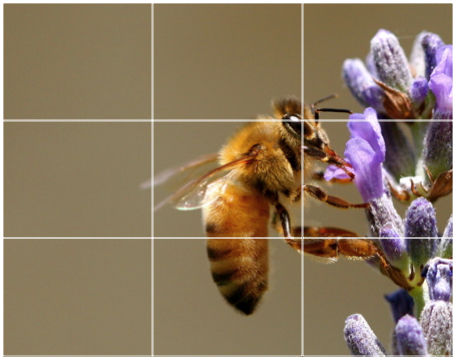Those who venture into photography and do not yet have a passionate professional photographic eye often go through uncomfortable situations in which they do not know where to turn. A beautiful landscape, a bustling city, a beautiful sunset is in front of the camera lens, but the photographer has difficulty thinking of a good framing for the elements of the scene to be recorded. It’s common, but there is a very effective technique that can help any photographer to record an image as accurately and beautifully as possible: the rule of thirds. The rule of thirds, in short, is a technique that explains how the elements of an image should be framed in a division of the camera screen? that we can mentally do in nine parts. The four central points formed by this division are the points where the main element of the photo should be. In the next photo, for example, the main element of the image, which is the child, is placed at the two central points on the left side of the photo. In general, the main elements can be at or near these points. In fact, according to studies and research on the human brain, it is at these points where our eye sees first and, therefore, when applying the rule of thirds, the image is not only more harmonious, but is enhanced in the eyes of others.
The rule of thirds can be very useful for photographing landscapes and transforming the photo not only into a reproduction image, but also to elevate the photograph to an informative, harmonious and even more pleasant level at eye level. Applying the third-party rule in this case, think about and analyze all the elements that your goal has. Even in the simplest scenarios, it can be applied: if you have an open field with no high details, such as trees, simply move the horizon line down, if your intention is to highlight the sky, or move it up, if you intend to highlight the field. In cases where there are trees, make sure that the tree you want to highlight is not in the center of the image. Place it at one of the four central points of the mentally made division, leaving the main object on the sides enriches the image because this is where the eye comes first, in addition to creating a kind of framing for the rest of the photographed environment, making the photograph more harmonious.
- The framing and composition of the landscape elements of the photographs also improve with the use of the horizontal and vertical lines present in the image.
- Across the horizon.
- The horizon is the main line of a landscape photograph.
- But in other situations.
- The photo can be guided by the arrangement of buildings.
- Trees and furniture.
- These main elements must be framed in the imaginary lines.
- So it is important to also identify the lines that form the elements of the image.
- Create a geometric effect and enhance the contours.
- Making them more harmonious and interesting for human eyes.
- However.
- Do not limit yourself to the rest of the lines and also use the curves of the image in your favor.
- Curves help to give the feeling of movement inside and you can also apply the rule of the thirds.
- In these ‘curvy movements’.
- The difference.
- However.
- Is that a curved object can be framed at an intersection point of the rule of thirds.
- Making the frame of the image elements even more sophisticated.
The rule of thirds is also very useful for taking quality portraits. For this, it is necessary to consider the eyes of the person to be represented as the main elements of the image. To give a sophisticated framing to a single face photo, you need to shift the person’s face slightly to the side until one eye is in the region of the four main points shown at the beginning of the text. This way, while the face will be slightly to the side, the eyes will be slightly up when considering the overall composition of the image. Another tip to further improve image quality is to create a sense of depth with background blur techniques. Therefore, the care given to the person will improve even more. If the case is a more open portrait, with more elements composing the image with the face of the person represented, the trick is that the face of the person is in a corner and the other element that deserves to be highlighted, but less important, is on the other side of the image, preferably slightly blurred. In portraits with more than one person, try to position the faces on the top horizontal line of the image. If the group is small, center people based on a side line in the image, not the center line.
Whether for portraits or landscapes, the important thing during the application is to try to place the objects in the image harmoniously to compose an eye-catching one, always thinking about assembling an imaginary frame and highlighting the essentials, without staying in the traditional. Centralized scenario, it should be remembered that, despite its name, it is only a photographic guide and not a rule that all photographers must follow, it can be broken without guilt when creating something artistic, however, if you are a beginner photographer, it is interesting to train the photographic eye by applying this technique until you fine-tune the vision to experiment with other elements and ways of photographing.
See also the article: THE HISTORY OF CINEMA AND PHOTOGRAPHY:?FRAME AND COMPOSITION OF THE MARK?

